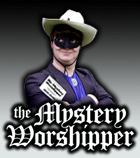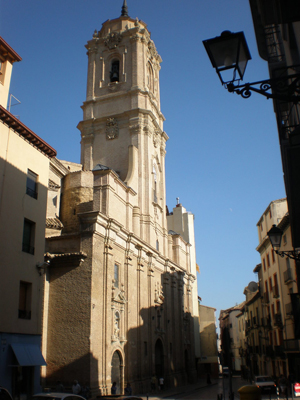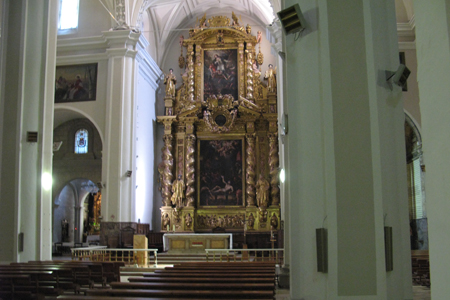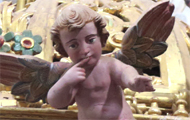| |
 |
 |
 |
| Comment on this report, or find other reports. |
 |
| Our Mystery Worshippers are volunteers who warm church pews for us around the world. If you'd like to become a Mystery Worshipper, start here. |
 |
| Find out how to reproduce this report in your church magazine or website. |
|
|
| 1884: San Lorenzo,
Huesca, Aragón, Spain |
 |

Photo: Murcianboy |
 |
Mystery Worshipper:
Augustine the Aleut.
The church:
San
Lorenzo (Royal and Collegiate Basilica Parish of St Lawrence),
Huesca, Aragón, Spain.
Denomination:
Roman Catholic, Diocese
of Huesca.
The building:
There have been churches in the neighbourhood for 13 centuries,
but the parish dates only from the 13th century. The church
itself is quietly baroque, and a substantial pile from the 17th
and 18th centuries – the foundation was laid in 1608. A plaque
at the entrance informs us that Pope Leo XIII promoted this
parish church to a basilica at the request of King Alfonso XII
and the parish chapter.
The church:
There are a number of groups that are active in the parish and
which are listed on their website.
The neighbourhood:
Huesca is a city in north-eastern Spain, within the autonomous
community of Aragon. The church is located in the heart of the
old city – but the rough end. In medieval times, it was the
Moorish quarter, and was a bit to the east of the Jewish ghetto.
The pilgrim walking up the Calle de San Lorenzo from the south
of the city will pass drug addicts (users of the hard stuff,
by the looks of it) hanging in doorways, as well as the Moroccan
and African workers who live in the poorer parts of Spanish
cities. To the north there are the 19th century shops and apartment
buildings of the south central end of the old city. About a
half-kilometre further north is the cathedral and the university
(with a very interesting museum of local history).
The cast:
Likely Francisco Atienza Delgado, the parish priest.
The date & time:
Monday, 14 September 2009, 7.30pm.
What was the name of the service?
Evening Mass.
How full was the building?
I counted 78 women and 56 men in a church that could potentially
hold around 300. There was a good range of people in the congregation,
including families. Several of the parishioners seemed to come
from the rough end of town, or had worked a very long day.
Did anyone welcome you personally?
I got a few friendly nods from parishioners, who probably noted that I was from out of town.
Was your pew comfortable?
I was seated in a moderately comfortable pew between the side
of altars of St Bernard and Our Lady of Pilar.
How would you describe the pre-service
atmosphere?
There was a fair bit of buzzing as people took their seats,
more than I am accustomed to in Spanish churches.
What were the exact opening
words of the service?
"En el nombre del Padre, y del Hijo, y del Espíritu
Santo." This was the end of Catalan-speaking territory,
and I was back into Castilian Spanish.
What books did the congregation
use during the service?
Much to my shock, there were pew bulletins! Only twice in my
life in Spain have I ever seen such things! I knew that I would
have to have a drink afterward to calm myself.
What musical instruments were played?
The organ played a few trancy pieces at the beginning and end.

Did anything distract you?
Immediately in front of me there were two teenaged girls, looking
a bit like comely refugees from a roller derby team workout,
who were escorting a younger teenager with Down's syndrome.
They were attentive to her, assisting her and chatting with
her, but were clearly not enraptured by the service. To my left
were two women who, although made up and coiffured, had likely
seen hard lives, but were quietly present, being soothed by
the service.
Was the worship stiff-upper-lip, happy clappy, or
what?
Less Mediterranean than the Catalan approach. Worshippers were
attentive in their demeanour. Huesca was on the rough end of
the Reconquista (Christian retaking of Spain from Muslim control,
culminating in 1492) and the Civil War, and there was still
a whiff of the frontier fortress and its preoccupations.
Exactly how long was the sermon?
8-10 minutes.
On a scale of 1-10, how good was the preacher?
8 – I found the throaty Aragonese pronunciation fairly,
surprisingly, and happily comprehensible.
In a nutshell, what was
the sermon about?
The priest gave a brief description of the day's gospel (Mark
8:27-35 – Peter confesses Jesus as the Messiah, but Jesus
rebukes him for not understanding that he must die and be resurrected).
Our weakness is to define Jesus with our preconceptions, but
only he can define himself, and it is for us to understand this.
Which part of the service
was like being in heaven?
After the teenagers returned from escorting their charge back
from receiving the sacrament, they continued to chat away. Their
Down's syndrome cousin spoke up in a voice that carried, saying
(my translation) that the priest had told her that, after they
ate the bread, they were to be silent and to think good thoughts.
Chatter around them began to die away as the message percolated.
And which part was like being in... er... the other place?
My mischievous delight in the discomfiture of those whose gossip had been interrupted by the young girl.
What happened when you hung around after the service looking lost?
I went to the sacristy to get my pilgrim's credential stamped
and was warmly welcomed by the priest. After he learned that
I was Canadian, he spoke in French. This also happened at other
churches along my pilgrimage. He then pulled out a bottle of
the local white lightning from the safe where the chalices
were kept, and poured me a stiff dram into a glass. He bade
me consume it in a gulp, for my health, to the merriment of
his sacristan and the two nuns helping out. One of the nuns
came up and spoke to me intensely for a minute, and then gave
me a prayer card for the canonisation of three local nurses
who had been martyred during the civil war.
How would you describe the after-service
coffee?
There's no after-service coffee here, but a nearby restaurant
supplied me with a substantial meal of lamb with peppers and
a bottle of the local red, all at an affordable price. As I
sat at my table at the side of the plaza, some parishioners
passed by me, making eye contact and giving me a slight nod.
How would you feel about making this church your regular (where 10 = ecstatic, 0 = terminal)?
8 – Not that I'll ever be here again, but the rough energy
and openness of the place appeal to me. A priest at the cathedral
had been rude and officious to me earlier in the day, so if
fate ever brought me back to Huesca, I would likely drop by
San Lorenzo rather than the cathedral. The martyred archdeacon
was the patron of my old school, and so I always have had a
soft spot for him.
Did the service make you feel glad to be a
Christian?
In a Spanish sort of way.
What one thing will you remember about all this in seven days' time?
The Down's syndrome girl giving us a brief lesson in how we
should behave.
More Camino reports |
|
|
 |
 |
 |
| We rely on voluntary donations to stay online. If you're a regular visitor to Ship of Fools, please consider supporting us. |
 |
 |
 |
| The Mystery Pilgrim |
 |
| One of our most seasoned reporters makes the Camino pilgrimage to Santiago de Compostela in Spain. Read here. |
 |
 |
 |
| London churches |
 |
| Read reports from 70 London churches, visited by a small army of Mystery Worshippers on one single Sunday. Read here. |
| |
|
|
|
|


